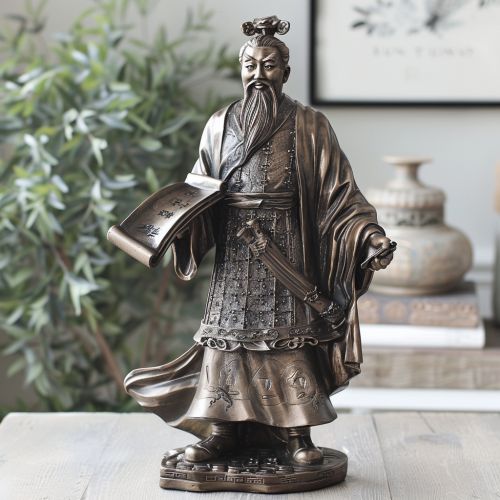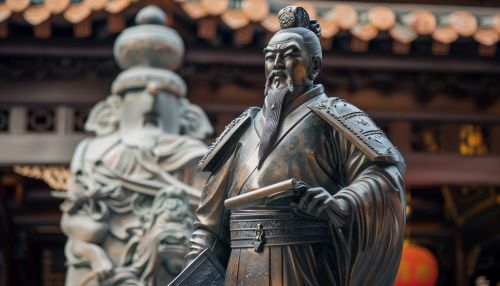Sun Tzu
Early Life and Historical Context
Sun Tzu, also known as Sunzi, was a Chinese general, military strategist, writer, and philosopher who lived during the Eastern Zhou period of ancient China. His birth and death dates are traditionally given as 544–496 BCE, although there is some debate among historians regarding the accuracy of these dates. Sun Tzu is most famous for his work "The Art of War," a treatise on military strategy and tactics that has had a profound influence on both Eastern and Western military thinking, business tactics, and legal strategy.
Sun Tzu's life and career unfolded during the tumultuous Spring and Autumn period (approximately 771 to 476 BCE) of the Eastern Zhou dynasty, a time marked by political fragmentation and frequent military conflict among rival states. This period set the stage for the development of various military philosophies and strategies, of which Sun Tzu's contributions remain the most enduring.
The Art of War
"The Art of War" is a comprehensive guide to warfare and military strategy, consisting of 13 chapters, each dedicated to a different aspect of warfare. The text emphasizes the importance of adaptability, deception, and strategic planning. It is considered one of the earliest and most influential works on military strategy.
Key Concepts
Sun Tzu's "The Art of War" introduces several key concepts that have become foundational in military strategy:
- **Strategic Advantage (Shi)**: The concept of leveraging one's position and momentum to gain an advantage over the enemy.
- **Deception (Zha)**: The use of misinformation and surprise to mislead the enemy and gain a tactical advantage.
- **Flexibility and Adaptability**: The ability to adapt to changing circumstances and respond to the enemy's movements.
- **Psychological Warfare**: The use of psychological tactics to demoralize the enemy and reduce their will to fight.
Chapter Summaries
- **Laying Plans**: Discusses the importance of planning and strategy in warfare.
- **Waging War**: Focuses on the economics of warfare and the importance of swift victories.
- **Attack by Stratagem**: Emphasizes the use of cunning and deception in warfare.
- **Tactical Dispositions**: Discusses the importance of positioning and the use of terrain.
- **Energy**: Explores the use of creativity and timing in warfare.
- **Weak Points and Strong**: Analyzes the strengths and weaknesses of both the enemy and oneself.
- **Maneuvering**: Discusses the complexities of direct and indirect warfare.
- **Variation in Tactics**: Emphasizes the need for flexibility and adaptability.
- **The Army on the March**: Focuses on the logistics and movement of troops.
- **Terrain**: Analyzes different types of terrain and their strategic implications.
- **The Nine Situations**: Discusses nine common situations in warfare and how to respond to them.
- **Attack by Fire**: Explores the use of fire as a weapon in warfare.
- **Use of Spies**: Emphasizes the importance of intelligence and espionage.


Historical Impact
Sun Tzu's influence extends far beyond his own time. His principles have been applied in various fields, including military strategy, business, sports, and even politics. The text has been studied by military leaders throughout history, including Napoleon, Mao Zedong, and Douglas MacArthur.
Influence in China
In China, "The Art of War" has been a staple of military education for centuries. It was required reading for generals and has influenced Chinese military thinking throughout the ages. During the Warring States period, many Chinese generals and strategists applied Sun Tzu's principles to their own campaigns.
Global Influence
"The Art of War" was introduced to Japan in the 8th century and became a significant influence on Japanese samurai culture and strategy. In the West, the text gained prominence in the 18th and 19th centuries, influencing European military leaders and theorists.
Modern Applications
Sun Tzu's principles have found applications in various modern fields beyond the military.
Business Strategy
Many business leaders and corporate strategists have adopted Sun Tzu's principles to gain competitive advantages in the marketplace. Concepts such as competitive analysis, strategic positioning, and market entry strategies are often informed by Sun Tzu's teachings.
Sports
Coaches and athletes in various sports have applied Sun Tzu's principles to develop game strategies, outmaneuver opponents, and achieve peak performance.
Legal Strategy
Legal professionals have also found value in Sun Tzu's emphasis on preparation, adaptability, and understanding the opponent's weaknesses, applying these principles in litigation and negotiation.
Criticisms and Controversies
While "The Art of War" is widely revered, it has not been without its critics. Some scholars question the historical accuracy of Sun Tzu's life and the authorship of "The Art of War." Others argue that the text's principles, while timeless, can be overly simplistic when applied to complex modern situations.
Authorship Debate
There is ongoing debate among historians regarding whether Sun Tzu was the sole author of "The Art of War" or if it was a compilation of works by multiple authors. Some suggest that the text may have been edited and expanded upon by later scholars.
Ethical Considerations
Some critics argue that the emphasis on deception and manipulation in "The Art of War" raises ethical concerns, particularly when applied outside the context of warfare. The use of such tactics in business or politics, for example, can lead to ethical dilemmas.
Legacy
Despite the controversies, Sun Tzu's legacy remains strong. "The Art of War" continues to be a foundational text in military academies and business schools around the world. Its principles are regularly cited in discussions of strategy and leadership.
Cultural Impact
Sun Tzu has become a cultural icon, representing wisdom and strategic acumen. His teachings are frequently referenced in literature, film, and popular culture, often symbolizing the timeless nature of strategic thinking.
